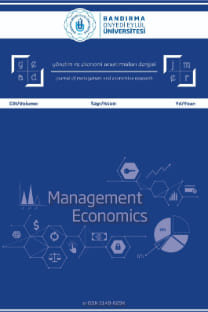Türkiye borsasının gelişmekte olan ülkeler borsaları ile eşbütünleşme analizi
Analysis of cointegration between Turkish stock exchange and stock exchanges in emerging markets
___
- An, L. ve Brown, D. (2010) Equity Market Integration between the US and BRIC Countries: Evidence from Unit Root and Cointegration, Research Journal of International Studies , 1(16): 15- 24.
- Assidenou, K.E. (2011) Cointegration of Major Stock Market Indices During The 2008 Global Financial Distress, Intenational Journal of Economics and Finance, 3(2): 212- 222.
- Benli, Y.K., Başçı, S. ve Değirmen, S. (2012) Common Stochastic Trend And Co - Integration in The Stock Exchange Markets: European Countries And Turkey, African Journal of Business Management, 6 (7) : 2565 -2577.
- Bayri, O. ve Güloğlu, B. (2005) Hisse Senedi ve Yabancı Para Piyasalarının Entegrasyonu: Türkiye, AB ve ABD Örneği, İktisat, İşletme ve Finans Dergisi, (234): 13 34.
- Bley, J. (2009) European Stock Market Integration: Fact or Fiction?, Journal of International Financial Markets , Institutions and Money, 19: 759- 776.
- Bozoklu, Ş. ve Saydam, İ.M. (2010) BRIC Ülkeleri ve Türkiye Arasındaki Sermaye Piyasaları Entegrasyonunun Parametrik ve Parametrik Olmayan Eşbütünleşme Testleri ile Analizi, M aliye Dergisi, (159): 416 -431.
- Boztosun, D. ve Çelik, T. (2011) Türkiye Borsasının Avrupa Borsaları İle Eşbütünleşme Analizi, Süleyman Demirel Üniversitesi İktisadi ve İdari Bilimler Fakültesi Dergisi, 16(1): 147- 162.
- Chang, T., Nieh, C.C. ve Wei, C.C. (2006) Analysis of Long-run Benefits from International Equity Diversification between Taiwan and its Major European Trading Partners: An Empirical Note, Applied Economics, 38: 2227- 2283.
- Çıtak, L. ve Gözbaşı, O. (2007) İMKB İle Bazı Önde Gelen Gelişmiş ve Gelişmekte Olan Ülke Borsaları Arasındaki Bütünleşmenin Temel Endeks ve Ana Sektör Endeksleri Temelinde Analizi, Dokuz Eylül Üniversitesi İktisadi ve İdari Bilimler Fakültesi Dergisi, 22(2): 249 -271.
- Dasgupta, R. (2013) BRIC and US Integration and Dynamic Linkages an Empirical Study for International Diversification Strategy, Interdisciplinary Journal of Contemporary Research in Business, 5(7): 536- 563.
- Diamandis, P.F. (2009) International Stock Market Linkages: Evidence from Latin Amerika, Global Finance Journal, 20(1): 13- 30.
- Dickey, D.A ve Fuller, W.A. (1979) Distribution of the Estimators for Autoregressive Time Series with a Unit Root, Jounal of the American Statistical Association, 74(366): 427- 431.
- Efendioğlu, E. ve Yörük, D. (2005) Avrupa Birliği Sürecinde Türk Hisse Senedi Piyasası ile Avrupa Birliği Hisse Senedi Piyasalarının Bütünleşmesi: İMKB Örneği, http://www.tcmb.gov.tr/yeni/iletisimgm/Enver_Efendioglu- Demet_Yoruk.pdf, (23.11.2013)
- Engle, R.F. ve Granger, C.W.J. (1987) Co- integration and Error Correction: Representation, Estimation, and Testing, Econometrica, 55: 251 276.
- Engsted, T. ve Lund, J. (1997) Common Stochastic Trends in International Stock Prices and Dividents: An Example of Testing Overidentifying Restrictions on Multiple Cointegration Vectors, Applied Financial Economics, 7: 659 -665.
- İbicioğlu, M. ve Kapusuzoğlu, A. (2011) İMKB İle Avrupa Birliği Üyesi Akdeniz Ülkelerinin Hisse Senedi Piyasalarının Entegrasyonunun Ampirik Analizi, Anadolu Üniversitesi Sosyal Bilimler Dergisi, 11(3): 85- 102.
- Johansen, S. (1988) Statistical Analysis of Cointegration Vectors, Journal of Economic Dynamics and Control, 12(1): 231 - 254.
- Johansen, S. ve Juselius, K. (1990) Maximum Likelihood Estimation and Inference on Cointegratio n: With Applications to the Demand for Money, Oxford Bulletin of Economics and Statistics, 52(2): 169 -210.
- Kasa, K. (1992) Common Stochastic Trends in International Stock Markets, Journal of Monetary Economics, 29: 95- 124.
- Korkmaz, T., Zaman, S. ve Çevik, E.İ. (2009) İMKB İle Uluslar Arası Hisse Senedi Piyasaları Arasındaki Entegrasyon İlişkisinin Yapısal Kırılma Testleri İle Analizi, Akdeniz İ.İ.B.F. Dergisi, (17): 40 -71.
- Mackinnon, J.G. (1996) Numerical Distribution Functions for Unit Root and Coint egration Tests, Journal of Applied Econometrics, (11): 601 - 618.
- Mavrakis, E.K. ve Alexakis, C.A. (2008) Stock Markets Linkages: An Empirical Investigation for Long- Term International Diversification Benefits, International Research Journal of Finance and Economics, 21: 163- 178.
- Morgan Stanley Capital International (MSCI ), http://www.msci .com/products/indices/country_and regional/em/performance.html, (29.10.2013).
- Paskelian, O.G., Nguyen, C.V. ve Jones, K. (2013) Did Financial Market Integration Really Happen in MENA Region? An Analysis, Journal of Economic Cooperation and Development, 34 (1): 111 -134.
- Samırkaş, M.C. ve Düzakın, H. (2013) İstanbul Menkul Kıymetler Borsasının Avrasya Borsaları İle Entegrasyonu, Uluslararası Hakemli Sosyal Bilimler E - Dergisi, (35): 1 -19.
- Seyidoğlu, H. (2003) Uluslararası Finans, İstanbul: Güzem Can Yayınları No: 19. Solnik, B.H. (1974) Why not Diversify Internationally Rather Than Domestically, Financial Analysts Journal, (July - August): 48 -54.
- Tahai, A., Rutledge, R.W. ve Khondkar, K.E. (2004) An Examination of Financial Integration for the Group of Seven (G7) Industrialized Countries Using an I(2) Cointegration Model, Applied Financial Economics, 14: 327- 335.
- Vuran, B. (201 0) İMKB 100 Endeksinin Uluslararası Hisse Senedi Endeksleri İle İlişkisinin Eşbütünleşim Analizi İle Belirlenmesi, İstanbul Üniversitesi İşletme Fakültesi Dergisi, 39(1):154- 168.
- ISSN: 2148-029X
- Yayın Aralığı: 4
- Başlangıç: 2013
- Yayıncı: Bandırma Onyedi Eylül Üniversitesi İ.İ.B.F.
Hasan ABDİOĞLU, Esma UYAR, Sedat YUMUŞAK
Cebrail MEYDAN, Sebahattin YILDIZ
Türkiye borsasının gelişmekte olan ülkeler borsaları ile eşbütünleşme analizi
Küresel kriz sonrası uluslararası para birimi olarak euro ve geleceği
Umut EVLİMOĞLU, Yasemin BOZDAĞLIOĞLU
Tms 18 hâsılat ve tms 2 stoklar standartlarına göre forfaıtıng işlemleri ve muhasebeleştirilmesi
Arap baharı'nın Türkiye ekonomisine etkileri1
Özge ŞAHİN UYSAL, Mehmet ŞAHİN
Adli muhasebede uzman tanıklık mesleği: Muhasebe meslek mensupları üzerine bir araştırma1
Fikret ÇANKAYA, Engin DİNÇ, Yurdagül ÇOBAN
Ramazan Eyüp GERGİN, Birdoğan BAKİ, İlker Murat AR
Türkiye ve başlıca ab pay piyasaları arasında asimetrik volatilite yayılımı 1
